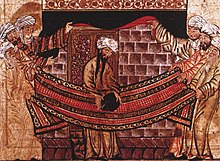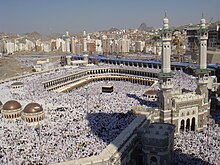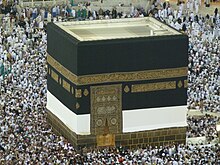Kaaba
The Kaaba (also Kaʿba , Arabic الكعبة, DMG al-Kaʿba ‚ cube ; Cube ') is a cuboid building in the inner courtyard of the Holy Mosque in Mecca and forms as "House of God" ( Arabic بيت الله bayt Allāh ) the central sanctuary of Islam .
Description of the building
The Kaaba is 13.10 m high and has a footprint of 11.03 m × 12.62 m. It stands on a 25 cm high marble base that protrudes 30 cm.
To the east is the black corner ( ar-rukn al-aswad ), named after the black stone that is attached here at a height of about 1.5 m. From here, the circumnavigation begins as one of the compulsory rites of the pilgrimage.
In the north of the Kaaba is the Iraqi corner ( ar-rukn al-ʿirāqī ), in the west is the Levantine corner ( ar-rukn aš-šāmī ), in the south the Yemeni (southern) corner ( ar-rukn al-yamānī ).
The entrance to the interior of the Kaaba is located on the north-east wall towards the black corner at a height of 2 m. It is reached by a wooden staircase on wheels that is usually stored between the arched Banu Shaiba Gate and the Zamzam Fountain.
The inside of the Kaaba is locked. The building is only opened twice a year for a cleansing ritual. Inside the Kaaba there are three pillars that support the ceiling and a small room called the “penance room”. The inner walls are clad halfway up with marble , which is perfumed with scented oil. Panels with Koran inscriptions are embedded in the marble. The upper part of the walls is covered with a green cloth, which in turn is decorated with verses from the Koran in gold embroidery .
The walls of the Kaaba are of a black brocade curtain covered the Kiswa is called, and in ⅔ height with gold-embroidered calligraphy of Koranic verses is decorated. The brocade curtain is renewed annually.
Outside the Kaaba, opposite the north-east wall, is the Abraham site (Maqām Ibrāhīm). It is a rock that Abraham is said to have climbed to complete parts of the building. This rock is now surrounded by a gold-colored six-sided lattice shrine.
Opposite the northwest wall is a semicircular white marble wall called Hatīm . It is 90 cm high and 1.50 m wide. The space between Hatīm and Kaaba, which is called the Hijr , is considered part of the Kaaba and is not entered during the Tawāf , the ritual encirclement. This is where the graves of Ismail and his mother Hagar are said to be . In the Hijr , the gutter pours, mīzāb , the Kaaba.
Importance in the religious life of Muslims
According to Islamic belief, the Kaaba (according to Sura 22/26) was built by Adam and the ruin was built by Abraham (إبراهيم / Ibrāhīm ) in cooperation with his son Ishmael on behalf of God as a place of pilgrimage .
Rites associated with the Kaaba
The great importance of the Kaaba is that it is both the goal of the great pilgrimage ( Hajj ), which every Muslim should undertake once in his life, if he is able to do so, as well as the small pilgrimage ( Umra ). As part of their pilgrimage in Mecca, the pilgrims circled the Kaaba seven times counterclockwise and praised Allah ; this circumnavigation becomes Tawāf (طواف) called.
In addition, the Kaaba is at the center of the Islamic prayer rite , because Muslims have to align themselves with the Kaaba with every prayer. The direction to the Kaaba, the Qibla , is usually emphasized in mosques by the mihrab . However, for most people it is enough to orientate themselves roughly to the Kaaba when praying. A hadith narrated by ʿAbdallāh ibn ʿAbbās says that “the house”, i.e. the Kaaba, is the qibla for the people who stay in the holy mosque , the holy mosque is the qibla for the people who are stay in the haram of Mecca, and the haram of Mecca is the qibla for the rest of the earth's inhabitants in the east and west from the Islamic ummah .
Simply looking at the Kaaba ( an-naẓr ilā l-Kaʿba ) is also considered a worship practice ( Übungibāda ).
Annual cleaning ceremony
The interior of the Kaaba is locked and not accessible to the public. The building is opened twice a year for a ceremony known as the cleaning of the Kaaba . This ceremony takes place 15 days before the start of Ramadan and before the start of the annual pilgrimage. The keys of the Kaaba are kept by members of the Banu Schaiba /بنو شيبةon. Tribesmen greet visitors during the purification ceremony. A small number of dignitaries and diplomats will be invited to attend the ceremony. The room is cleaned with a broom and washed with a mixture of zamzam and rose water .
history

In pre-Islamic times, the Kaaba was worshiped by Arab tribes as the sanctuary of the god Hubal . The pre-Islamic Kaaba cult included, in addition to the worship of Allah , the worship of the goddesses al-Lat , Manat and Uzza . Even in pre-Islamic times there was a special priesthood connected with the Kaaba and called hijāba . The holders of this office kept the keys of the Kaaba. The first holder of this office is said to have been Qusaiy ibn Kilāb , the actual founder of the Quraish tribe . After his death, this office was passed on to the descendants of his eldest son ʿAbd ad-Dār.
In the early 7th century, the Kaaba was destroyed by fire. The young Mohammed is said to have been involved in the reconstruction: When the various Quraish clans were arguing about who was allowed to attach the black stone, he settled the dispute by suggesting that the black stone should be placed on a cloth that should be used by members of all clans was held. He then attached the black stone himself.
After taking Mecca in January 630, Mohammed confirmed the descendants of ʿAbd ad-Dār of the Abū Talha family in their position as porters of the Kaaba. He had ʿUthmān ibn Talha, a member of the Abū-Talha family, who was in charge of the porter's office at that time, bring the key to the Kaaba, entered the Kaaba and then gave the key back to him. He is said to have spoken the following words: “Take him, you sons of Abu Talha, as an entrusted good of God. Treat it properly for all eternity. Only a violent criminal will snatch him from your hands. ”Since 632 the Kaaba has been a purely Islamic sanctuary.
The Kaaba rebuilding of ʿAbdallāh ibn az-Zubair
The Kaaba was badly affected in 683 in the conflict between the Umayyad caliph Yazid I and ʿAbdallāh ibn az-Zubair . The military leader Husain ibn Numair, who besieged the city on behalf of Yazīd, had it shot at with throwing machines from the surrounding mountains. On October 31, 683, the cloaks of the Kaaba caught fire, the flames spread to the woodwork and the building collapsed. Abdallāh ibn az-Zubair then had the Kaaba completely demolished so that it could be rebuilt. This decision was criticized by many of the Prophet's companions , including ʿAbdallāh ibn ʿAbbās . Since ʿAbdallāh ibn az-Zubair stuck to his decision, a large part of the city's residents moved to Minā because they feared that demolishing the building would bring God's punishment on them. Since no one was found who dared to start, ʿAbdallāh ibn az-Zubair himself had to climb the wall and throw down the stones. Only when it was clear that nothing was happening to him did the Meccans return to their city. The demolition of the building was completed on February 8, 684. So that the believers could continue to perform their Tawāf and prayers undisturbed, the place of the Kaaba was covered with cloths.
When building the new building, Abdallāh ibn az-Zubair intended to restore the Kaaba "to its previous state", which had existed before the Quraish was rebuilt at the beginning of the 7th century. In doing so , he relied on a statement by his aunt Aisha bint Abi Bakr , according to which the Prophet himself was willing to reverse the changes made by the Quraish after the capture of Mecca, but with regard to the fact that they had just converted to Islam had not implemented. According to the prophetic word handed down by Aisha, to which ʿAbdallāh ibn az-Zubair referred, the Quraish had not erected the hatīm wall, which originally reached to the roof, when they rebuilt the Kaaba due to a lack of money, but instead had the second door originally located on the back the Kaaba was closed and the floor of the Kaaba was raised so that it could only be reached by stairs. The Prophet had explained this by saying that the Quraish wanted to show their superiority in this way, since they could now let anyone enter the Kaaba or throw them down the stairs at their will. With reference to this hadith, ʿAbdallāh ibn az-Zubair had a second door opened on his new Kaaba on the eastern side of the building, the floor of the Kaaba was lowered to ground level and the Hatīm wall was raised to an apse. In March 685 the building was inaugurated in this new shape.
After al-Hajjaj ibn Yūsuf had taken Mecca on behalf of ʿAbd al-Malik ibn Marwān in 692 , he had the structural changes made to the Kaaba by ʿAbdallāh ibn az-Zubair undone. ʿAbd al-Malik is said to have regretted the recent change in the building by al-Hajjāj, when al-Hārith ibn ʿAbdallāh, a former governor of ʿAbdallāh ibn az-Zubair in Basra , told him the authenticity of Aisha's statement, on which ʿAbdallāh referred to Az-Zubair had called, confirmed.
Later story
Later Umayyad rulers made their mark through generous donations to the Kaaba. For example, al-Walid I had the rain gutter of the Kaaba gilded for the first time.
In 931 the “Black Stone” was carried off to Bahrain by the Ismaili Qarmatians ; It was not until 951 that he returned to Mecca (through the mediation of the Ismaili Fatimids ).
After the Kaaba was so badly damaged in a flood in 1630 that it threatened to collapse, the Ottoman Sultan Murad IV ordered a new building that same year. The current building dates from this time.
When a bomb exploded during the occupation of the Grand Mosque in 1979 , the floor of the Kaaba was destroyed. Various idols of pre-Islamic Altarabic deities were found under the rubble, but they were immediately removed by the Saudi authorities. Nothing is known about the whereabouts of the idols.
The origins of the Kaaba according to Islamic tradition
The Abraham-Ishmael cycle
Already in the Meccan suras of the Koran the Kaaba is represented as an Abrahamic sanctuary: God once commissioned Abraham to clean this house for those who wanted to do prayer exercises and the circulation there, and asked the people to go on a pilgrimage to the Kaaba (sura 22: 26-27). A text from Medinian times (Sura 2: 127) says that Abraham built the foundation walls of the "house" (i.e. the Kaaba) together with his son Ishmael (إسماعيل, DMG Ismāʿīl ). These Koranic statements form the basis for the extensive cycle of Islamic legends about Abraham and Ishmael's building of the Kaaba. According to a tradition that is traced back to īAlī ibn Abī Tālib , it was the Sakīna who brought Abraham to Mecca when he did not know where to build the new sanctuary. The cult founded by Abraham on the Kaaba is said to have been monotheistic. It is said that it was not until rAmr ibn Luhaiy from the Arab tribe of the Chuzāʿa, who lived a few generations after him, that the Arabs were seduced into idolatry.
The Kaaba as the starting point of creation
In a Koranic passage from Medinian times (Sura 3:96) there is the statement that “the house” ( bayt ) in Mecca was the first that was built for the people. This is followed by the Islamic conception of the Kaaba as the origin and starting point of creation, which is based on various traditions from the companions of the prophets . A version narrated in the name of the Koran exegete ʿAbdallāh ibn ʿAbbās reads: “The house with its four corners was placed on the water 2000 years before the world was created. Then the earth was spread out under her. "
After this original structure fell apart, Adam (آدم Ādam ) have re-established the Kaaba in the same place. When it fell apart again, Abraham built the new building.
See also
literature
- ALFA Beelaert: “The Kaʿba as a Woman: a Topos in Classical Persian Literature” in Persica 13 (1988/1989) 107–123.
- Richard Ettinghausen : "The pictorial representation of the Kaʿba in the Islamic culture area" in the magazine of the Deutsche Morgenländische Gesellschaft 87 (1934) 111-137.
- Abdelaziz Gouda: The Kiswa of the Kaʿba in Makka . Dissertation, FU Berlin, 1989.
- Günter Lüling : The Christian cult on the pre-Islamic Kaaba as a problem of Islamic studies and Christian theology . Erlangen: Lüling 1977.
- GRD King: "The Paintings of the Pre-Islamic Ka'ba" in Muqarnas: An Annual on the Visual Culture of the Islamic World 21 (2004) 219-230.
- Uri Rubin: “The Kaʿba: aspects of its ritual functions and position in pre-Islamic andearly Islamic times” in Jerusalem Studies in Arabic and Islam. 8 (1986) 97-132.
- Uri Rubin: Ḥanīfiyya and Kaʿba. An inquiry into the Arabian pre-Islamic background of dīn Ibrāhīm. In: Jerusalem Studies in Arabic and Islam . 13: 85-112 (1990).
- Janine Sourdel-Thomine: Clefs et serrures de la Ka'ba. Notes d'épigraphie Arabe . Librairie Orientaliste Paul Geuthner, Paris, 1971.
- Ferdinand Wüstenfeld : History of the city of Mecca, edited from the Arabic chronicles. Leipzig 1861. Digitized
Web links
- Live video from the Kaaba (government of Saudi Arabia)
Individual evidence
- ↑ See Rubin 1990, 85 ff. And Rubin 1986.
- ↑ Information about the interior
- ↑ To the Abraham site
- ^ The Encyclopaedia of Islam . New Edition. Brill, suffering. Vol. 3, p. 31: “It is a duty obligatory on every Muslim man or woman who has reached the age of puberty and is of sound mind to perform the ḥadjdj once in his or her life provided that they have the means to do so. "For this determination see also sura 3, verse 97 (after Paret ):" And people are obliged to God to make the pilgrimage to the house - as far as they find a possibility. "
- ↑ al-Baihaqī : Kitāb as-Sunan al-kubrā . Ed. Muḥammad ʿAbd al-Qādir ʿAṭā. Dār al-Kutub al-ʿilmīya, Beirut, 2003. Vol. II, p. 16. Digitized
- ↑ Cf. al-Azraqī: Kitāb Aḫbār Makka . Ed. F. Wüstenfeld, Leipzig 1859, p. 255 f.
- ↑ Cf. Ferdinand Wüstenfeld : Chronicles of the City of Mecca . Fourth volume. Leipzig 1861. p. 31. ( archive.org ).
- ↑ Quotation from al-Azraqī : Aḫbār Makkata wa-mā ǧāʾa fī-hā min al-āṯār . Ed. Desert field. Leipzig 1858. p. 67. Available online here: archive.org Cf. the German summary at Wüstenfeld § 109.
- ↑ See Wüstenfeld §§ 134-135.
- ↑ See Wüstenfeld §§ 135-136.
- ↑ See Wüstenfeld § 145.
- ↑ Cf. F. Wüstenfeld: History of the City of Mecca, edited from Arabic chronicles . Leipzig 1861, p. 151.
- ^ F. Wüstenfeld: The Sherif of Mecca in the XI. (XVII.) Century . Göttingen 1887, p. 35.
- ^ The Encyclopaedia of Islam. New Edition. Brill, suffering. Vol. 9, p. 5.
- ↑ See Reuben Firestone: Journeys in Holy Lands. The Development of the Abraham-Ishmael legend in Islamic exegesis. Albany 1990, pp. 80-93.
- ↑ See Reuben Firestone: Journeys in Holy Lands. The Development of the Abraham-Ishmael legend in Islamic exegesis. Albany 1990, p. 68.
- ↑ See also Tilman Nagel: Mohammed. Life and legend. Munich 2008, p. 25 f.
- ↑ See also Tilman Nagel: Mohammed. Life and legend. Munich 2008, p. 19.
- ↑ See the Quran commentary Zād al-masīr fī ʿilm at-tafsīr by Ibn al- Jschauzī on sura 3:96.
Coordinates: 21 ° 25 ′ 21.2 ″ N , 39 ° 49 ′ 34.1 ″ E






